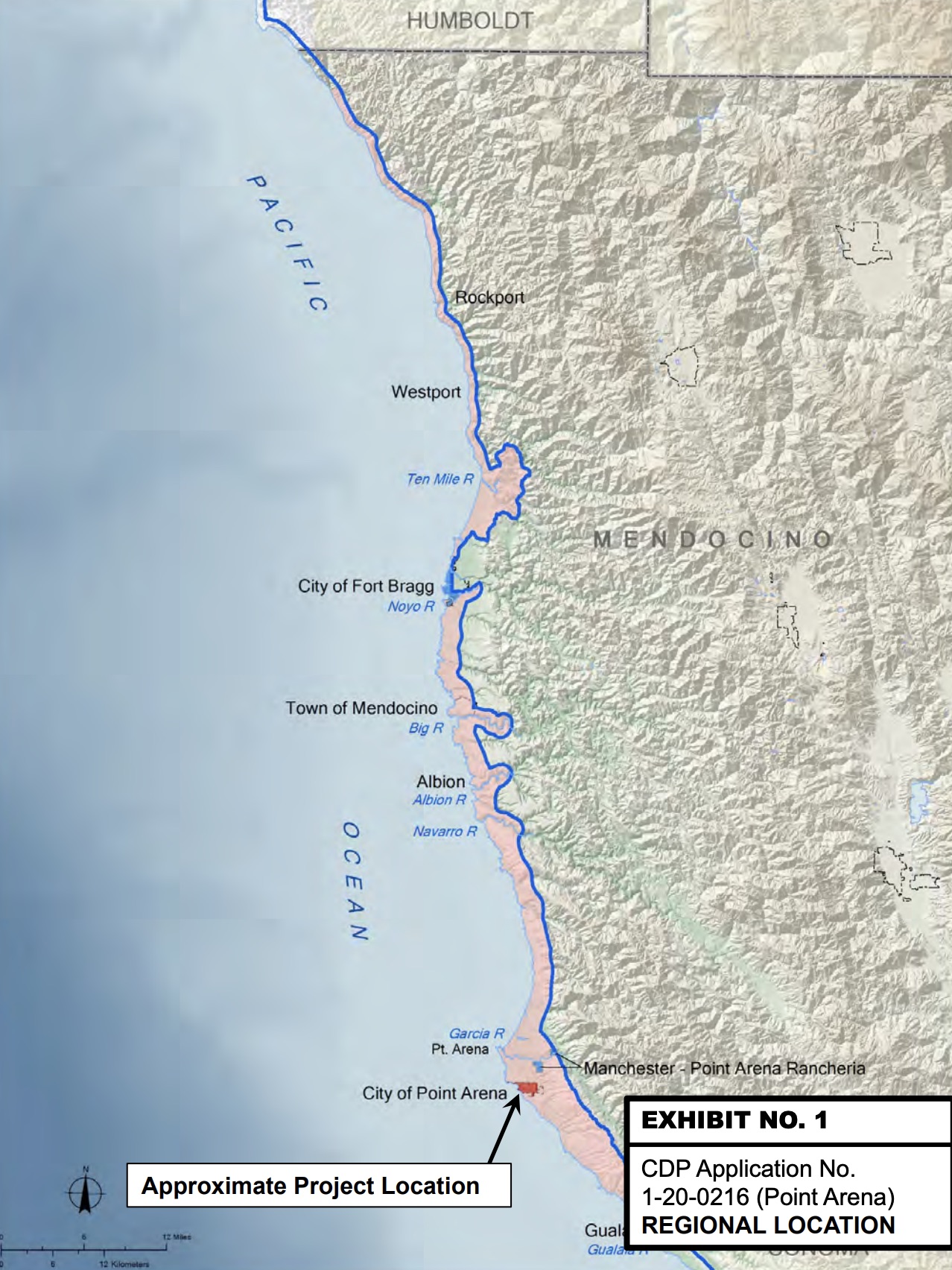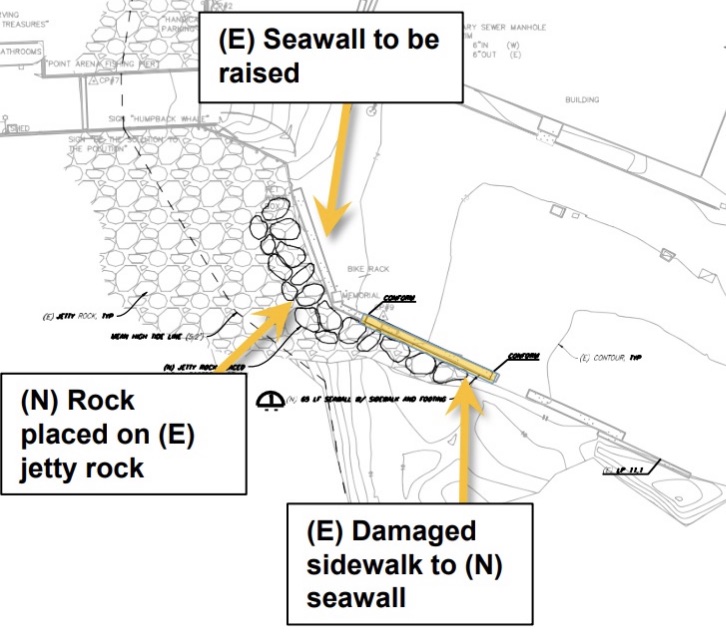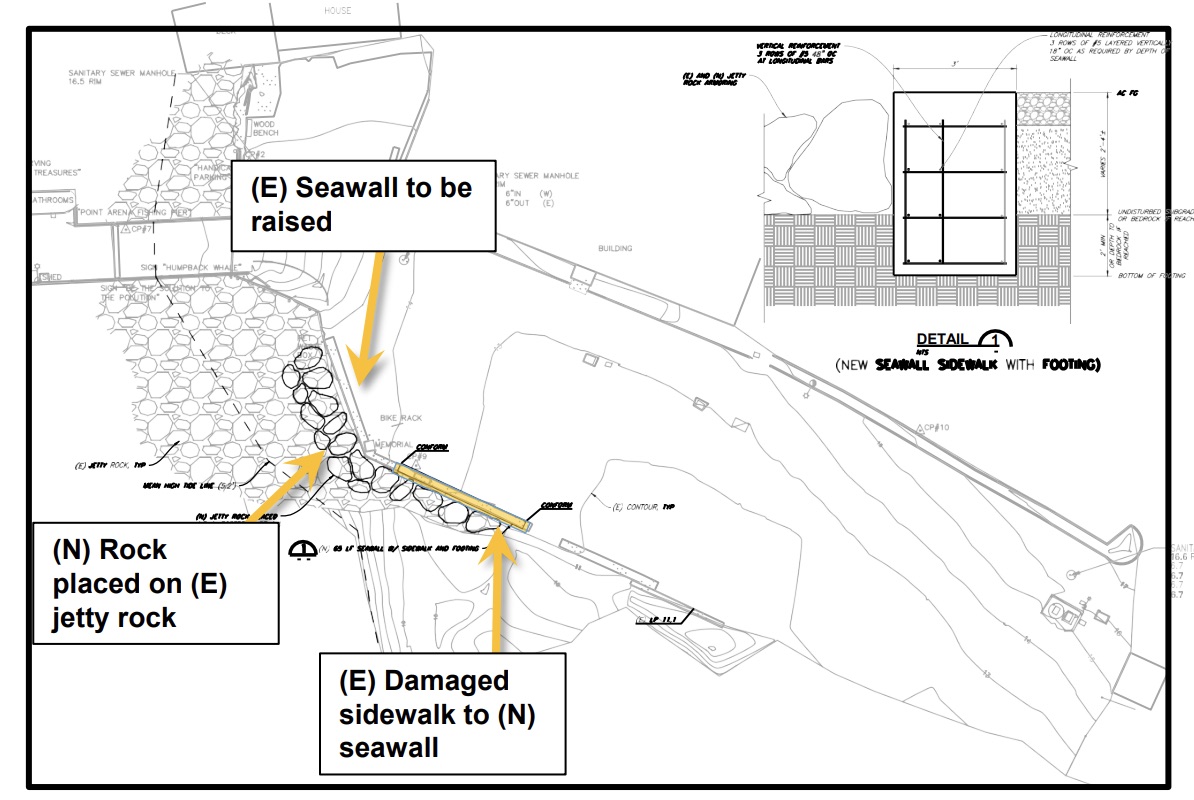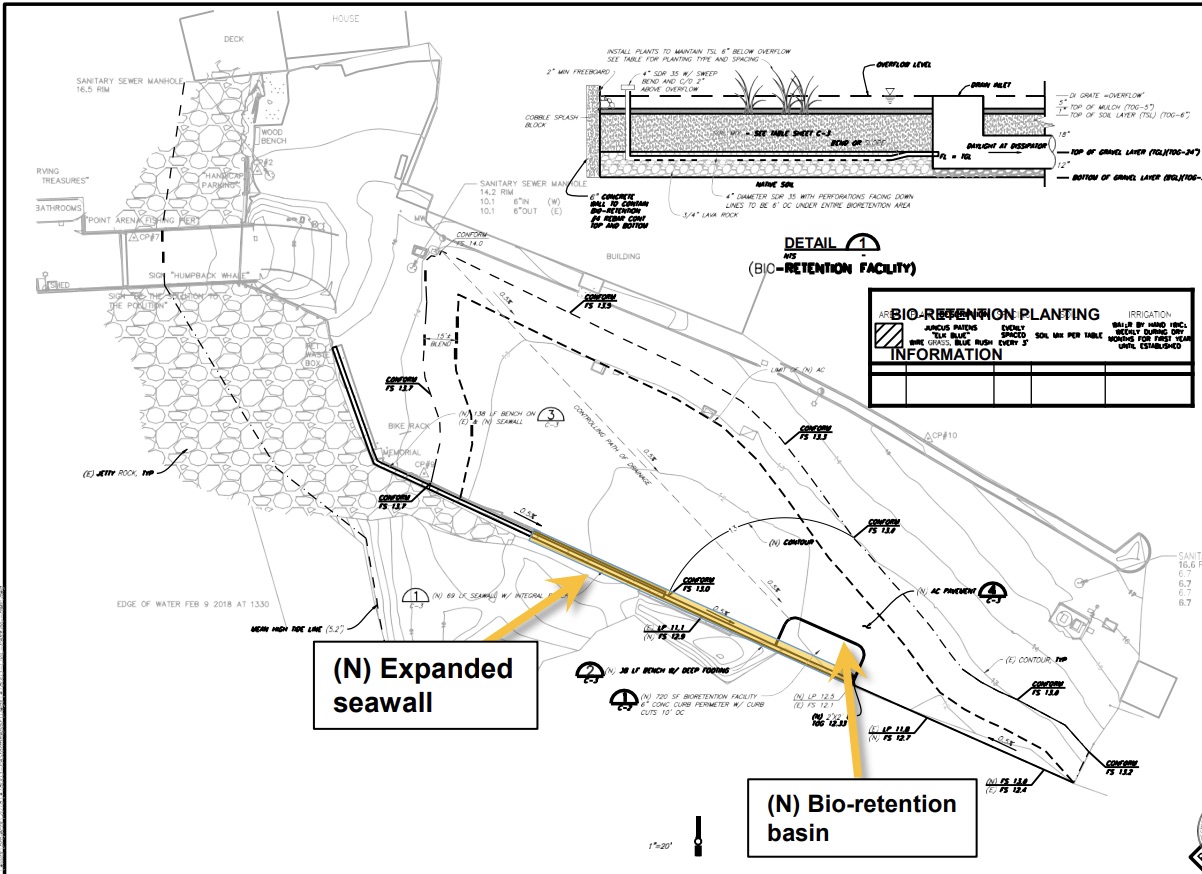|
Getting your Trinity Audio player ready...
|
STAFF REPORT.
 SUMMARY OF STAFF RECOMMENDATION 1/5/2021
SUMMARY OF STAFF RECOMMENDATION 1/5/2021
The City of Point Arena proposes to repair and improve the Arena Cove parking lot which serves coastal dependent commercial and recreational fishing uses by (a) regrading and repaving portions of the parking lot, (b) adding a two-foot-high bench atop an existing low floodwall (seawall), (c) expanding the seawall along the length of the existing parking lot, (d) installing a new bio-retention basin, and (e) raising a portion of the existing parking lot.
Arena Cove is a popular destination in Mendocino County that supports commercial and recreational fishing, public access, and an array of recreational uses. The Cove is often used for City-wide events and festivals. Arena Cove is vulnerable to flooding and erosion from infrequent but intense winter storms. The current protective devices were permitted by the Commission under a 1985 permit to repair and replace the pier and parking lot following a storm. The proposed repairs and improvements would address damages caused by a 2016 winter storm and improve flood protection. The parking lot is regularly flooded during winter storm events when Arena Creek, which flows adjacent to the parking lot, mixes with ocean water and overtops the existing parking lot edge.
The primary Coastal Act issue associated with this project is the proposed seawall expansion and augmentation of rock revetment resulting in construction that alters natural shoreline processes. The seawall is required to protect coastal dependent commercial fishing uses. Staff recommends Special Conditions 1 through 8 to assure that the project is consistent with the relevant Coastal Act policies. The project, as conditioned, involves the least environmentally damaging feasible alternative for the proposed improvements, and therefore staff is recommending approval consistent with the requirements of section 30235.
In addition, surveys for the endangered Point Arena Mountain Beaver (PAMB) did not identify any evidence of the species at the project site and the U.S. Fish & Wildlife Service staff has advised Commission staff that the development should not adversely affect nearby PAMB environmentally sensitive habitat.
Staff believes that the project, as conditioned, includes all feasible mitigation measures necessary to find the project consistent with the Chapter 3 policies of the Coastal Act. The motion to adopt the staff recommendation of approval with special conditions is on page 4.
The Full CCC Staff Report for Point Arena Armoring
[pdf-embedder url=”https://www.coastsidebuzz.com/wp-content/uploads/2021/02/Point-Arena-CCC-Staff-report.pdf” title=”Point Arena CCC Staff report”]
From Stanford Law School
Environment and Natural Resources Law & Policy Program
California Coastal Armoring Report:
Managing Coastal Armoring and Climate Change Adaptation in the 21st Century
“A common perception is that seawalls and revetments protect the coast. Although such armoring structures may temporarily protect property from encroachment by the sea, they accelerate erosion of existing beaches and coastal habitats in the areas where they are located, limit beach access, and impede coastal recreation. Scientific evidence shows that coastal armoring structures prevent coastal ecosystems from migrating inland and cut off sand supply by preventing natural erosion processes.
Put simply, when placed on an eroding or retreating beach, armoring structures will cause that beach to narrow and eventually disappear.
Wave energy reflecting off of shoreline armoring structures also undercuts the beach and can hasten coastal erosion in front of the structure as well as on neighboring properties, harming those properties and stimulating yet more armoring.
In short, many of California’s beaches, and the amenities and ecosystems they provide, may inevitably disappear due to armoring.”
[pdf-embedder url=”https://www.coastsidebuzz.com/wp-content/uploads/2021/02/stanford-CACoastalArmoringRpt.pdf” title=”stanford CACoastalArmoringRpt”]
CCC on Armoring September 1995
ReCAP Pilot Project Findings and Recommendations: Monterey Bay Region
This chapter summarizes ReCAP’s investigation of shoreline hazard response — protection of upland development by armoring, the permitting associated with existing armoring, the impacts from armoring, the policies which address shoreline protection, and the likely changes which will happen to the shoreline in the future assuming existing trends and policies continue. A major finding of this effort is that current coastal policies support the use of public shoreline and public resources to protect private property and if the current situation continues, more and more of the public shoreline will be lost as a public resource. While only an eighth of the ReCAP coastline is now armored, over a third of the ReCAP coastline has the land use and physical characteristics which could require armoring in the future. None of this includes the shoreline already protected by groins, jetties and breakwaters. There are substantial portions of coastline which can be affected by the land use and armoring policies which are in effect.
Most property owners consider shoreline armoring only after they perceive a threat to their development and believe that without armoring, their home or business will be damaged or destroyed. In many cases, the hazards posed by storms and coastal erosion can be serious. Statewide, on average, shoreline hazards cost $100 million annually, either from damage due to storms and erosion, or for shoreline armoring and modification designed to protect against storms and erosion.[1] Breakdown for the ReCAP area is not available; however, a substantial amount of public and private funds are being expended routinely to address coastal hazards.
The ReCAP Coastal Hazards team examined in detail the concerns that: (1) there is no consistent regional approach to address areas prone to shoreline erosion, (2) impacts to shoreline access from armoring are often overlooked, (3) armoring is often put in place during emergency storm events which may have significant impacts to the coast but which has little overall analysis, and 4) the building setbacks for much of the shoreline development in urban portions of the ReCAP pilot area are often inadequate. Examination and analysis of these concerns led to recommendations for improvements in the procedures for developing regular permit conditions, issuing emergency permits, and establishing setbacks. Recommendations also include efforts to introduce a more regionally based plan for shoreline protection. While the recommended changes in procedures could provide some immediate improvement in the management of coastal hazards, longer-term efforts could require changes to Coastal Act policies. The hazards team identified a number of changes and revisions to the Coastal Act itself which could modify or clarify the overall direction for safe development in areas of high coastal hazards. Individually, or in combination, these recommended changes and modifications would provide coastal planners with tools and resources to plan for future shoreline hazards and safe development. >> READ MORE
CALIFORNIA COASTAL COMMISSION NORTH COAST DISTRICT OFFICE
1385 EIGHTH STREET, SUITE 130 ARCATA, CA 95521
VOICE (707) 826-8950 F AX (707) 826-8960







